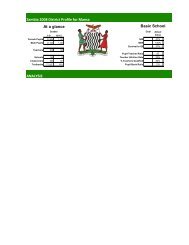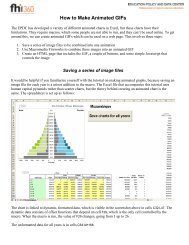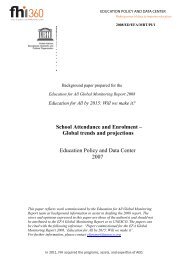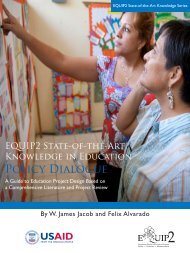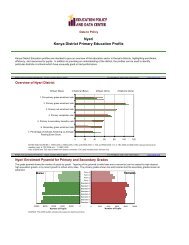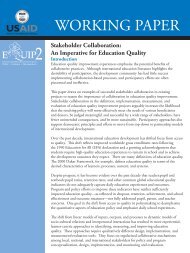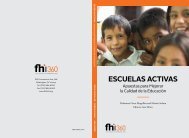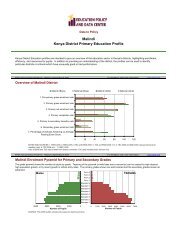EQUIP2 Final Report.pdf - Education Policy Data Center
EQUIP2 Final Report.pdf - Education Policy Data Center
EQUIP2 Final Report.pdf - Education Policy Data Center
Create successful ePaper yourself
Turn your PDF publications into a flip-book with our unique Google optimized e-Paper software.
14<br />
<strong>EQUIP2</strong> Leader Award <strong>Final</strong> <strong>Report</strong><br />
recognized that the rapid increase in access was having a devastating impact<br />
on school quality, shifting attention to the issues of retention, completion,<br />
and learning. The global shift from access to quality provides the backdrop<br />
for <strong>EQUIP2</strong>’s research in this area. From the beginning, <strong>EQUIP2</strong> researchers<br />
sought to answer the question: How do alternative education models meet<br />
the education needs of underserved populations in developing countries?<br />
Complementary <strong>Education</strong><br />
When <strong>EQUIP2</strong> began in 2003, much of the discourse in educational<br />
development focused on the achievement of <strong>Education</strong> for All. Patterns in<br />
the international data revealed readily identifiable groups that were out of<br />
school, including girls, children in rural areas, AIDS orphans, and others.<br />
Meanwhile, the literature was replete with examples of large-scale, nongovernmental<br />
educational programs that were successfully reaching these<br />
populations in some of the world’s poorest countries. It was this reality, along<br />
with a dearth of studies to examine why “alternative” programs were so much<br />
more effective than government schools, that led the <strong>EQUIP2</strong> consortium<br />
to investigate the cost-effectiveness of reaching the underserved through<br />
non-governmental education programs. By examining how such programs<br />
were successfully reaching underserved groups, <strong>EQUIP2</strong> would be in a<br />
position to advise governments and donors on cost-effective strategies for the<br />
achievement of <strong>Education</strong> for All.<br />
However, the label “alternative education” did not appropriately represent<br />
the types of programs the team was reviewing. Indeed, the term “alternative<br />
education,” commonly used in developedcountry<br />
contexts, primarily referred to charter<br />
schools, alternative schools, independent<br />
schools, and home-based learning programs<br />
– all true alternatives to public schools. In<br />
<strong>EQUIP2</strong>’s research, however, the children<br />
from underserved communities were not<br />
choosing among several school options<br />
because they only had one. Other common<br />
labels for non-governmental education<br />
programs included “community schools”<br />
and “non-formal learning,” but these were<br />
also inadequate monikers to describe broadbased,<br />
NGO-run education programs in areas<br />
that had no government schools at all. The<br />
Bangladesh Rural Advancement Committee<br />
(BRAC), identified by <strong>EQUIP2</strong> researchers,<br />
was a high-profile example: in 2004, there<br />
“One outcome of the panel session<br />
on complementary education at the<br />
2006 Comparative and International<br />
<strong>Education</strong> Society (CIES) in Hawaii<br />
was that <strong>EQUIP2</strong>’s analysis and data<br />
was highly appreciated, particularly<br />
in application to access, completion,<br />
and learning issues. Participants<br />
noted the importance of linking<br />
<strong>EQUIP2</strong>’s work to sector planning,<br />
collection of sub-national data, and<br />
teacher recruitment, training, and<br />
support. Both <strong>Education</strong> for All (EFA)<br />
and UNESCO’s Institute for Statistics<br />
(UIS) plan to release data and information<br />
on serving the underserved.”<br />
<strong>EQUIP2</strong> Quarterly Meeting Notes,<br />
June 8, 2005




